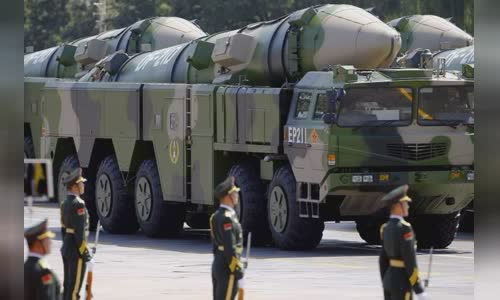The Chinese launch of a missile into the South China Sea could give the US a tougher stance towards Beijing, increasing the risk of armed conflict.
A source close to the Chinese military said that the country fired two anti-ship ballistic missiles, including the DF-26B from Qinghai and the DF-21D from Zhejiang, into the South China Sea on August 26 morning.

The vehicle carried the DF-21 during a parade in Beijing in 2015 Photo: Reuters
A day earlier, China said that the US U-2 reconnaissance was "provocative" when moving into the "no-fly zone", where China practiced August 25-29 in the Bohai area.
The US Department of Defense on August 27 released a statement saying that China had tested four ballistic missiles during an illegal exercise around Vietnam's Paracel Islands, questioning Beijing's 2002 commitment to avoid
The DF-26 has a range of 4,000 km and can be used in either a nuclear strike or conventional attacks on land and sea targets.
DF-21D has a range of 1,450 km, speed over 12,000 km / h, equipped with conventional or nuclear warheads equivalent to 300,000 tons of TNT.
Derek Grossman, a security expert from the American consultancy Rand, said the missile launch would make the US more skeptical of China's intentions and would further strengthen Washington with Beijing in all aspects:
Grossman argues that a war between China and the US is unlikely, but warns of an armed conflict at risk due to miscalculation.
Chen Gang, assistant director of the East Asia Institute at the National University of Singapore, said that China's display of its DF-class missiles during past Beijing parades and their launch from distant locations showed.
The missile launch took place when the US and China were stressed on many issues, from economics to security.
"The US continues to test China's limits on Taiwan and South China Sea issues, prompting China to display military might to show Washington that even the US aircraft carrier cannot do it all.
US Defense Secretary Mark Esper said the Chinese government over the years modernized to develop a "world-class" military and therefore increasingly took drastic action in the South China Sea and East China Sea.
Wu Qian, a spokesman for China's Ministry of Defense, said in a regular news conference on Aug. 27 that the military exercises in the South China Sea did not target any specific countries, but called on the US
"China opposes and is not afraid of US provocations. We urge some American politicians to evaluate reality in an objective way, stop provocations and bring US-China relations back to normal," he said.
Malcolm Davis, senior analyst at the Australian Institute of Strategic Policy, agrees with Grossman and said the missile tests would further raise concerns about China's intentions and challenge due to China's military capabilities.
"The US may not respond to this test by changing its foreign policy stance, but the US will find that it has to take China's missile capabilities very seriously," Davis said.
Steve Tsang, a political scientist from University College London, said the prospects for the future US-China relationship are very negative, the US Navy will continue to operate freely in the South China Sea, or increase
Isaac Kardon, an expert from the China Maritime Research Institute at the US Naval University, said that while the missile tests are likely to give momentum to the "hawk" stance in Beijing and Washington, the risk of climbing
Zack Cooper, an expert at the Center for Strategic and International Studies at the American Enterprise Institute, said that the missile test was essentially no problem.



 JoAnna Wass
JoAnna Wass







